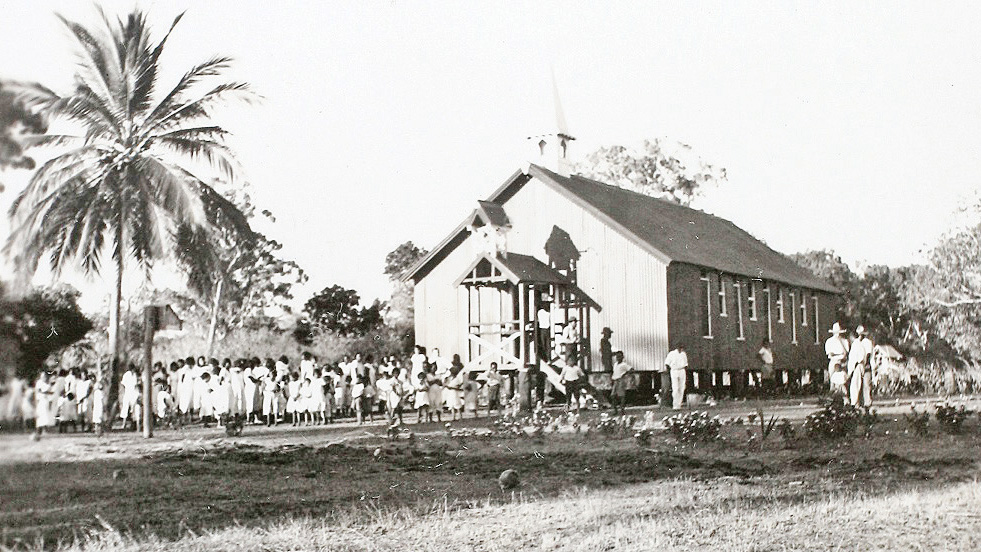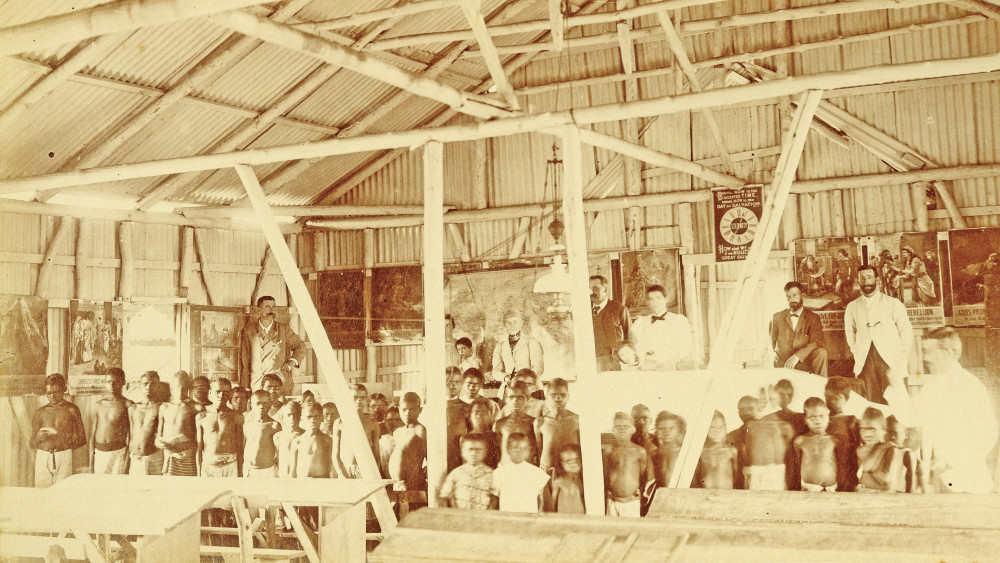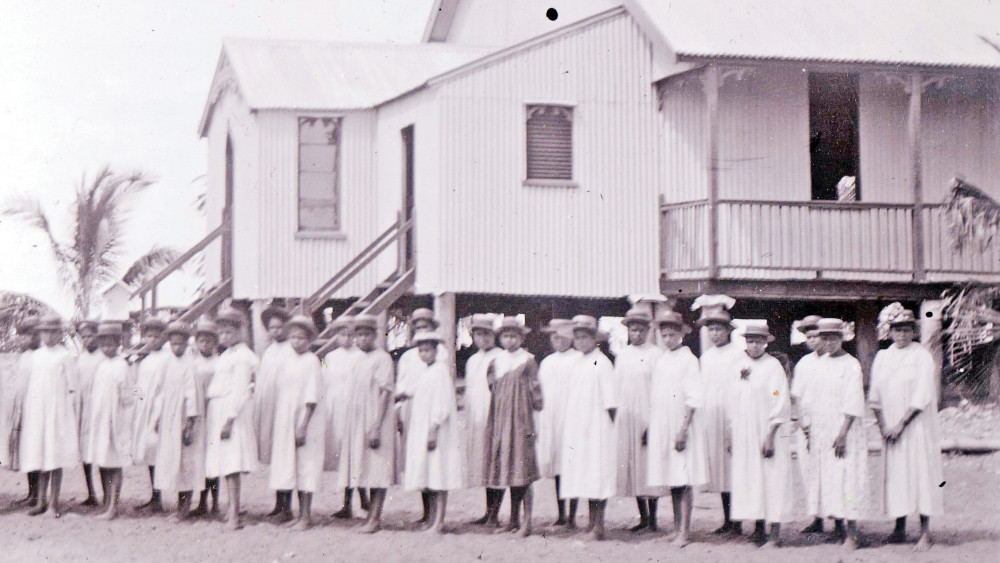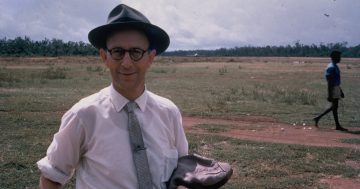
Mapoon has a complicated history and the roles of various churches in the community sit side-by-side with the Cape York community’s story. Historian GEOFF WHARTON kindly put together this piece to remind us why the opening of the Mapoon Memorial Church was a special occasion for the community.
THE opening of the church at Mapoon last Thursday is an event that links today’s Christian movement in the community with the earliest days of Mapoon Presbyterian Mission and the Moravian Church missionaries who came to evangelise among the Tjungundji People in 1891.
Moravians were Protestants whose Church had been formed in Saxony, Germany during the 18th century by persecuted escapees from the region of Moravia, which is within the modern country of the Czech Republic in central Europe.
Moravians became involved in missionary activity in remote regions across the world.
When the Presbyterian Church in Australia decided to establish a mission at the Batavia River (renamed Wenlock River about 1940) in the early 1890s, they turned to Moravian evangelists to provide the people to work with Aboriginal people of the region.
Placed under contract to the Presbyterian Church, Moravians were to serve in the foundation and early years of Mapoon, Weipa and Aurukun.
Originally named Batavia River Mission, but known by its language name Mapoon from October 1892, the small community was established on the western shores of Port Musgrave by English Moravian, Reverend James Gibson Ward and German Moravian, Reverend John Nicholas Hey (pronounced Hi), in November 1891.
Ward and Hey married two Irish Moravian sisters, Matilda and Mary Anne (Minnie) Barnes.
By November 1892, Hey had constructed a basic church building to encourage the Tjungundji People to worship.

Although 19th century missionaries often ignored or repudiated the spiritual beliefs of Aboriginal people, there is evidence that Ward and Hey endeavoured to learn the Tjungundji and Yupungayth languages and thus better understand the traditional customs.
Following Ward’s death from fever in January 1895, Matilda Ward continued to serve as the mission teacher until 1917, while the Heys remained in charge of Mapoon until October 1919.
As the mission population grew, Hey oversaw the construction of another church building in 1896 and this had the dual purpose of a school.
Mapoon’s population expanded during the early 1900s with the arrival of children of mixed-descent from the Gulf region as a result of Mapoon being declared a reformatory dormitory.
These children had been forcibly removed by police from their families under Queensland government policies of the time.
Children affected by these policies were early members of the stolen generations.
By 1905, Hey considered that a much larger church was required. Mapoon men travelled up the Batavia River to harvest timber which was then cut to shape and size with pit saws back at the mission.
A Yupungathi man, Barkley, was a skilled carpenter who crafted much of the internal timber fittings of the church.
An article published in the Presbyterian Women’s Missionary Association journal, Ministering Women, described the new church construction which was led by the South Sea Islander, Peter Bee, as foreman:
“The three tie beams in the Church are heavy hardwood pieces 35 feet long. The walls, roof, and ceiling are of galvanised iron. The Church is over 30 feet wide by over 50 feet long, having a small verandah on either side formed by the eaves being carried on several feet beyond the wall plates.
This provides shade on the walls, and has permitted of about two feet of the upper part of each side wall being made of banister rods only, giving infinitely better ventilation than any public building Thursday Island possesses …
This form of roof structure required solid work; and it is all there, the tie beams being bound to the walls by massive natural-crook knees bolted into the top plates. The porch, windows, and doors are ornamented with frieze work all cut out by the blacks.
The northern end has three skillion rooms, the centre of which might be described as a vestry, with a dressing-room on either side – one for the girls and one for the boys wherein they change their working apparel for their ‘best’ clothing.”
It was usual practice in Moravian churches for men and boys to sit on one side of the church during services and women and girls on the other side and this was practised at Mapoon.
Elders who grew up during the dormitory time before the 1940s recalled how they were required to polish a brass plaque memorial to founding missionary Reverend James Gibson Ward, which was displayed in the church named in his honour. On Saturday, June 9, 1906, missionaries from Aurukun, Weipa and Mapoon assembled for the official opening of the J.G. Ward Memorial Church.

The Weipa missionaries, Edwin and Thekla Brown, with teacher Laura Schick and dormitory children, had made a remarkable nine-day journey overland guided by 20 Weipa Aboriginal men.
Ministering Women described how the Browns travelled with horse drawn vehicles and constructed a track for wheeled vehicles between the two missions.
Describing the church opening service, Mr Hodel from Thursday Island wrote:
“The congregation must have numbered quite 300 souls, nearly all of whom found seating accommodation.
Short addresses were given by Revs. Brown and Richter, which were listened to most attentively.
The singing was very good indeed by both the Mapoon and Weipa contingents, who sang separate anthems as well as unitedly.”
In 1907, the Musgrave outstation (the name being derived from Port Musgrave) was established about 6km south of the mission where young families created small farming areas.
A church constructed from local timber and with thatched grass walls and palm leaf roof was built there by Mapoon men, led by New Hebridean (now Vanuatu) Dick Kemp and opened in October 1910.
Just six years later, Hey asked another South Sea Islander, Lui Samoa, to commence an outstation about 24 kilometres up the Batavia River.
This place, now known as Batavia Landing on the Wenlock River, was designed to be a training farm for young men when they left school.
Writing in 1923, Nicholas Hey noted that the outstation church “sat on the brow of the hill overlooking the winding river”.
No photograph of that church has been located to date.
Eventually, the Batavia outstation closed during the 1930s, but even today there is evidence of this village with old mango trees growing near the landing site.
The first church at the Musgrave outstation was superseded in 1919, when it was reported that a new church “measuring 26 ft. x 33 ft. (8 x 10 metres), capable of accommodating 100 people, and built entirely by Mapoon carpenters from locally grown and locally prepared timber, was dedicated and opened for worship by Mr Hey at the Musgrave Settlement”.
The Heys left Mapoon soon afterwards and were succeeded by Reverend J.R.B. (Bob) Love MC, DCM, a decorated veteran of the Australian Light Horse.
By 1934, the Musgrave church required replacement, so a new building was constructed, complete with a tall sheet-iron steeple, situated near the northern side of the current cemetery at Mapoon.
This was during the time when William Miller was acting superintendent.
Towards the end of the Second World War, missionary Frank Cane decided to dismantle the Musgrave outstation church and some of the building materials were used to construct a new school at the mission.
Other materials from the church were loaded on the Presbyterian sailing vessel Morning Star to be transported to Aurukun Mission.
Unfortunately, the vessel was grounded on a reef, south of Mapoon and broke up from wave action.
During the 1950s and early 1960s, few funds were made available by the church and government for new buildings or repairs at Mapoon, so the J.G. Ward Memorial Church gradually fell into disrepair.
However, it was still used for services, even after the Presbyterian missionaries departed in 1963.
There followed a terrible time for Mapoon people, when the Queensland Director of Native Affairs, Patrick Killoran, pressured them to leave their beloved homeland.
In November 1963, police were sent down from Thursday Island to forcibly remove 24 people to the Northern Peninsula Area under orders from Killoran with the full knowledge and approval of the Presbyterian Board of Missions and the Queensland Minister for Education, Jack Pizzey.
By May 1964, all of the Mapoon people had moved away, either to Weipa Mission, to New Mapoon and other Queensland localities.
Killoran sent a team of Torres Strait Islander carpenters to dismantle all remaining buildings including the J.G. Ward Memorial Church.
Despite the physical destruction of their community at the hands of the Queensland government, the spiritual connection to their homeland remained strong in the hearts of the Mapoon people.
A long campaign of public awareness for land rights by people such as Jean Jimmy, Hazel Miller, Rachel and Simon Peter, Jerry and Ina Hudson and others led to the re-establishment of Mapoon community, commencing with cottages made from bush materials in the mid-1970s.
Real progress towards a renewed community commenced with the establishment of the Marpuna Community Aboriginal Corporation by Silva Blanco and others in 1984.
Until local government status was achieved, the Marpuna Corporation was the administrative body working with governments to create new community facilities.
A remarkable community planning process conducted by Mapoon health workers Mervyn Wales, Linda McLachlan and Robert Cockatoo with the Centre for Appropriate Technology in 1994-1995, gave full voice to the Mapoon people.
Their input led to the well-spaced attractive community that exists today.
Finally in the year 2000, the Mapoon Aboriginal Council was formed to provide full local government status to the community.
lAuthor Geoff Wharton OAM thanks Florence Charger and other Mapoon Elders in past years for their generous sharing of memories of Mapoon history.



